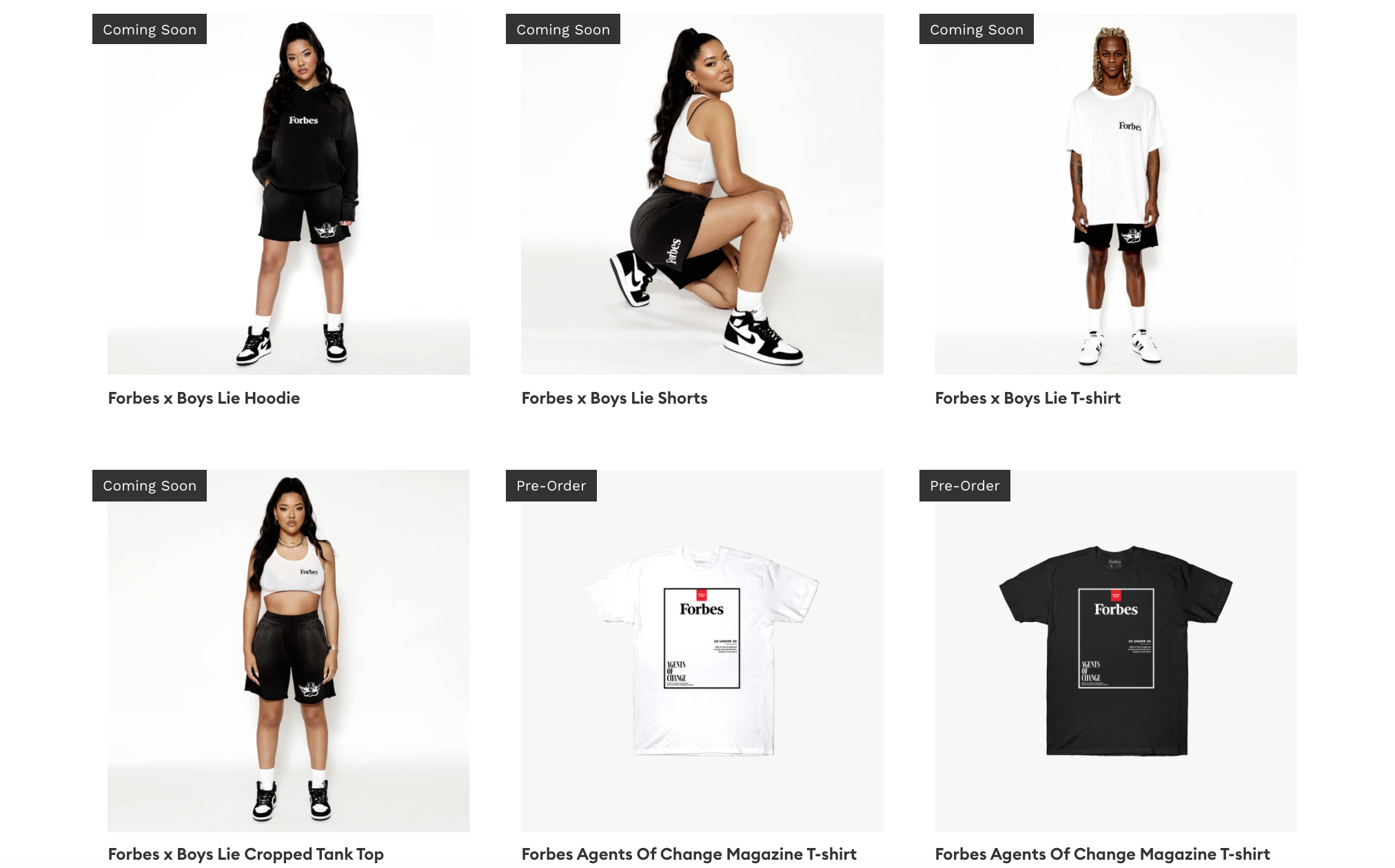
Forbes this week became the latest big-name publisher to launch its own online store selling branded clothing and accessories.
The Forbes Store, launched in partnership with apparel brand Boys Lie, sells Forbes-branded shorts, hoodies, T-shirts, caps, tote bags and baby bibs.
The media firm has been ramping up its e-commerce business since early 2020 through Forbes Vetted, through which it earns affiliate revenues, and Forbes Coupons.
And it is not alone. The New York Times and Economist already have well-established stores, while publishers like Buzzfeed, Group Nine and Conde Nast are in the process of expanding their own e-commerce offerings.
Last year’s advertising market slowdown forced publishers to accelerate efforts to find new, non-traditional revenue sources. The growing e-commerce market is seen by many as a key opportunity.
Click here to subscribe to Press Gazette’s must-read newsletters, Future of Media and Future of Media US |
Q&A with Forbes on e-commerce
After the opening of the Forbes Store, Press Gazette conducted an email Q&A with Emily Jackson, Forbes’ vice president for e-commerce, to find out more about the company’s ambitions in this area.
She explains how e-commerce fits into Forbes’ wider business strategy, including how it can add to the firm’s first-party data.
Jackson also tells us why she believes readers will pay to wear the Forbes brand – but why not all publishers with a big audience could pull this off.
Q: Forbes is one of several publishers currently expanding its e-commerce operations. Why? What is driving this trend?
“E-commerce continues to provide a promising way for publishers to diversify revenue streams while allowing them to build, nurture and grow a direct-to-consumer business.
“On-site affiliate content, when done right, can strengthen a brand’s authority and trust while driving meaningful revenue from both sales and advertising.
“Whereas an online storefront can be the foundation for a true content to commerce strategy, while at the same time, enhancing the publisher’s first-party data.”
Q: Why do you think publishers like Forbes are well placed to enter the e-commerce market from a practical perspective? I.e. Is it because lots of people already visit the Forbes website?
“While scale may be a contributing factor to launching a store, we believed we were well placed to enter the market because of the communities we’ve spent decades building.
“From Forbes Women to 30 Under 30 and our CMO network to Small Business, we have deep relationships with these communities.
“This spans from their demographics, to the content they consume, to the events they attend and the newsletters they subscribe to.
“Based on these insights, we believed we could create products that they would want to buy and wear because it would reflect their core values and interests, not just because it had the logo of a publication they read.”
Q: You only recently launched the Forbes Store. Have you had many customers so far?
“It is still early days, but we’re very happy with the performance and feedback on the store and our products so far.”
Q: Who is the average Forbes Store customer in your mind? How do they currently interact with Forbes? What job do they have? Where do they live? And why will they buy Forbes-branded merchandise?
“Each collection caters to a different segment of the Forbes audience, so we can get super targeted about what value we’re providing to our users.
“The merchandise in each of our collections align with that particular audience’s values, tastes and behaviours.
“Our core collection caters to our brand loyalists, readers who have read Forbes all their lives and return to our site multiple times a month and have watched the Forbes brand evolve over time.
“Our collaboration with Boys Lie focuses on a younger demographic who aspire to be the next innovators and perhaps in a future class of 30 Under 30.
“Our Forbes Women collection will create apparel for our large community of women entrepreneurs, business leaders and innovators, and reflects the journeys they have taken to get where they are today.”
Q: Many large publishers might believe their brand is not strong enough to sell merchandise. Are they being pessimistic?
“No. I think that can be true. When you ask consumers to buy and then wear merchandise and apparel, you cannot solely rely on the fact that you have a large audience of readers who read your content.
“Scaling a business like this relies on not only having a strong brand but being able to tell the story of the brand, identify and understand your readers and truly connect with the audience you are selling to.”
Q: When did Forbes first start experimenting with e-commerce and how successful has it found schemes like Forbes Vetted and Forbes Coupons to be?
“Forbes had a small e-commerce operation in late 2018, but we really began scaling up in early 2020.
“E-commerce at Forbes has been the fastest growing business over the last 18 months with the e-commerce team growing over 1,000% in the same time period.
“We’re committed to the continued growth of the Forbes Vetted business; to developing the team’s coverage to go wider and deeper into our current content categories, as well as launching new areas of coverage all while delivering the best product recommendations for our audience.”
Email pged@pressgazette.co.uk to point out mistakes, provide story tips or send in a letter for publication on our "Letters Page" blog
